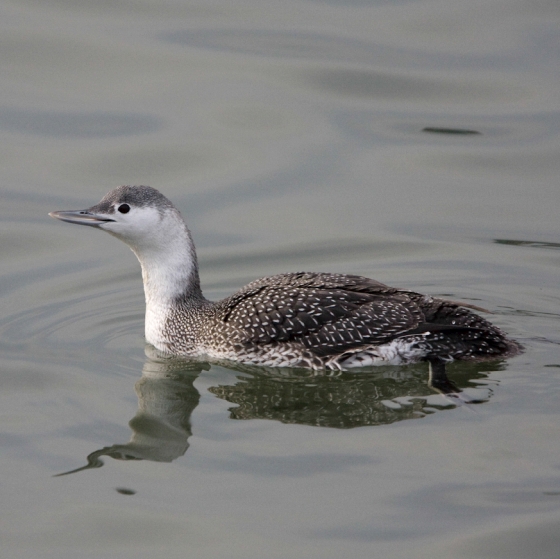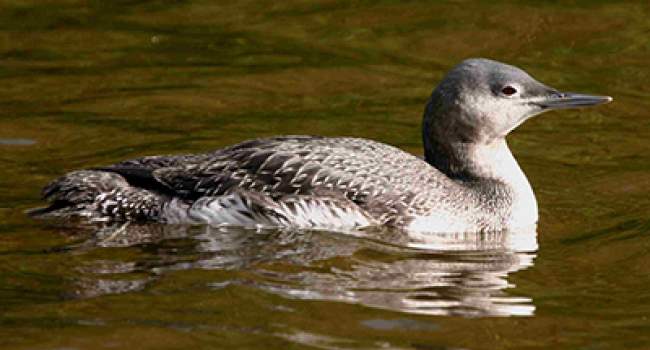Red-throated Diver
Gavia stellata (Pontoppidan, 1763)
RH
 RETDI
RETDI  20
20

Family: Gaviiformes > Gaviidae

The Red-throated Diver has a restricted breeding distribution within Britain and Ireland, favouring small lochs and lakes close to the sea in the north of Ireland and north and west of Scotland.
The small breeding population is joined by a much larger number of birds during the winter months, when individuals can be found around our entire coastline – although with the greater proportion of these to be found off the east coast.
The Red-throated Diver is a well-studied, long-lived species; data from bird ringing reveal that individuals regularly reach 25 years of age. The species feeds mainly on small fish.
Exploring the trends for Red-throated Diver
Our Trends Explorer will also give you the latest insight into how the UK's Red-throated Diver population is changing.
trends explorerIdentification
Red-throated Diver identification is sometimes difficult. The following article may help when identifying Red-throated Diver.
Identifying winter divers

Divers in winter can be confusing and difficult to identify. Let this video help you to confidently separate Red-throated, Black-throated and Great Northern Divers.
SONGS AND CALLS
Listen to example recordings of the main vocalisations of Red-throated Diver, provided by xeno-canto contributors.
Flight call
Song
Develop your bird ID skills with our training courses
Our interactive online courses are a great way to develop your bird identification skills, whether you're new to the hobby or a competent birder looking to hone your abilities.
Browse training coursesStatus and Trends
Population size and trends and patterns of distribution based on BTO surveys and atlases with data collected by BTO volunteers.
CONSERVATION STATUS
This species can be found on the following statutory and conservation listings and schedules.
POPULATION CHANGE
Breeding numbers are quite variable between years and not monitored annually by the BTO; trends are hard to assess except by intensive survey. There was a full UK survey in 1994 (935 pairs; Gibbons et al. 1997) and a repeat in 2006, by when the estimated UK breeding population had increased significantly by 34%, with stability in Shetland and Orkney but increase across the Hebrides and Scottish mainland (Dillon et al. 2009). Complete surveys of Shetland indicated a decrease of 36% there between 1983 and 1994 (Gomersall et al. 1984, Gibbons et al. 1997) and there was minor further decrease there by 2006 (Smith et al. 2009). The full surveys indicate that Shetland held 46% of the national total of breeding pairs in 1994 and 33% in 2006, though this decrease reflects the significant increases elsewhere in Scotland rather than the small decline in Shetland (Smith et al. 2009). JNCC's Seabird Monitoring Programme shows that breeding numbers at sample study areas in Shetland fluctuated without long-term change during 1980-2005, with low points in 1980, 2000 and 2004 (Mavor et al. 2008). Though previously amber listed through its 'depleted' status in Europe, the species was moved to the UK green list in 2015 (Eaton et al. 2015). Wintering numbers, mostly of birds from northern Europe, peaked in 2011/12 but have since decreased and are now similar to numbers in the early 1990s (WeBS: Frost et al. 2020).
Since the 1980s, there may have been some tendency for more pairs to hatch a second chick, although two-chick broods are only occasional in Orkney and changes in the distribution of nests recorded might have influenced the results. In 2011, however, there were fewer two-chick broods in Shetland than in any year since at least 1979 (Holling et al. 2013).
Exploring the trends for Red-throated Diver
Our Trends Explorer will also give you the latest insight into how the UK's Red-throated Diver population is changing.
trends explorerDISTRIBUTION
Wintering Red-throated Divers are recorded all round the coast of Britain & Ireland, plus at a scatter of inland sites, mainly in northern and eastern England. The highest concentrations are along North Sea coasts, southwest Scotland and southwest Ireland. Breeding birds are restricted to freshwater lochs and bogs in Co. Donegal in Ireland and in north and west Scotland.
Occupied 10-km squares in UK
| No. occupied in breeding season | 345 |
| % occupied in breeding season | 11 |
| No. occupied in winter | 785 |
| % occupied in winter | 26 |
European Distribution Map
DISTRIBUTION CHANGE
Red-throated Diver winter range has expanded by 32% since the 1981–84 Winter Atlas, with a large part of this being off northwest Scotland and parts of western Ireland. Some of this increase may be due to better coverage but some gains are likely to be real.
Change in occupied 10-km squares in the UK
| % change in range in breeding season (1968–72 to 2008–11) | +11.3% |
| % change in range in winter (1981–84 to 2007–11) | +32.7% |
SEASONALITY
Red-throated Divers are recorded year-round

Movement
Information about movement and migration based on online bird portals (e.g. BirdTrack), Ringing schemes and tracking studies.
RINGING RECOVERIES
View a summary of recoveries in the Online Ringing Report.
Foreign locations of birds ringed or recovered in Britain & Ireland

Biology
Lifecycle and body size information about Red-throated Diver, including statistics on nesting, eggs and lifespan based on BTO ringing and nest recording data.
PRODUCTIVITY & NESTING
Exploring the trends for Red-throated Diver
Our Trends Explorer will also give you the latest insight into how the UK's Red-throated Diver population is changing.
trends explorerSURVIVAL & LONGEVITY
View number ringed each year in the Online Ringing Report
Maximum Age from Ringing 
|
35 years 11 months 23 days (set in 2018) 
|
Typical Lifespan 
|
9 years with breeding typically at 3 year |
Adult Survival 
|
0.84  
|
Juvenile Survival 
|
0.37 (to age 2) 
|
Exploring the trends for Red-throated Diver
Our Trends Explorer will also give you the latest insight into how the UK's Red-throated Diver population is changing.
trends explorerBIOMETRICS
Wing Length 
|
Adults | 289.9±9.7 | Range 279–304mm, N=21 |
Body Weight 
|
Adults | 1.68±0.21 | Range 1.43–2.03kg, N=20 |
Feather measurements and photos on featherbase 
CODES & CLASSIFICATION
Ring size 
|
K* |
Field Codes 
|
2-letter: RH | 5-letter code: RETDI | Euring: 20 |
For information in another language (where available) click on a linked name
Research
Interpretation and scientific publications about Red-throated Diver from BTO scientists.
CAUSES AND SOLUTIONS
Causes of change
There is little good evidence available regarding the drivers of the breeding population change in this species in the UK.
Further information on causes of change
No further information is available.
Information about conservation actions
The main drivers of change are not known for these species. However, because food for chicks is obtained largely from the sea close to breeding lochs, a reliable supply of suitable marine prey nearby is a requirement for successful breeding. Shortages of sand eels have recently been a major factor in depressing breeding success in Shetland (Forrester et al. 2007). Divers are thus vulnerable to losses of feeding grounds and to decreases in fish stocks and hence policies which protect marine areas adjacent to breeding areas would be prudent until the reasons for the decline have been confirmed.
Outside the breeding season, this species is believed to be among the most sensitive to offshore wind farms, and in particular at risk of displacement from wind farms (Furness et al. 2013; Wade et al. 2016; Heinanen et al. 2020), and therefore winter distribution should be taken into account when making decisions about wind farm developments, to protect both British and European breeding birds.
PUBLICATIONS (1)
Real-time species distribution models for conservation and management of natural resources in marine environments
Links to more studies from ConservationEvidence.com
- Floating platforms increase the reproductive success of common loons
- Education, communication and outreach (ECO) success stories: solving conservation problems by changing behavior
- Creation and management of artificial nesting sites for wetland birds
Read more studies about Red-throated Diver on Conservation Evidence >
Would you like to search for another species?













Share this page